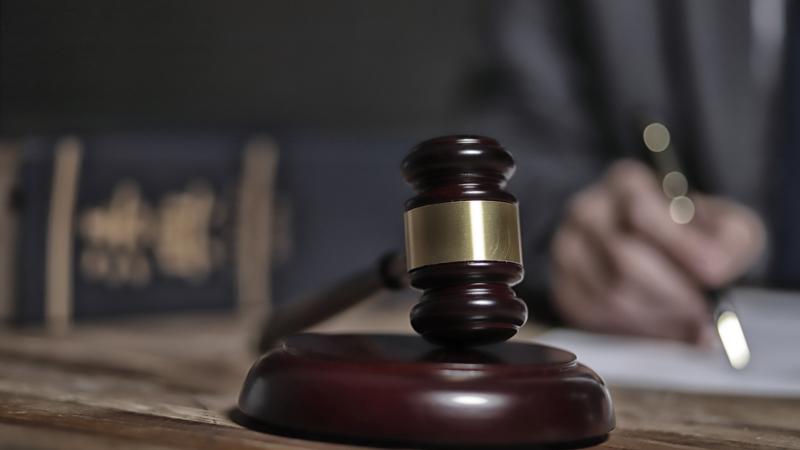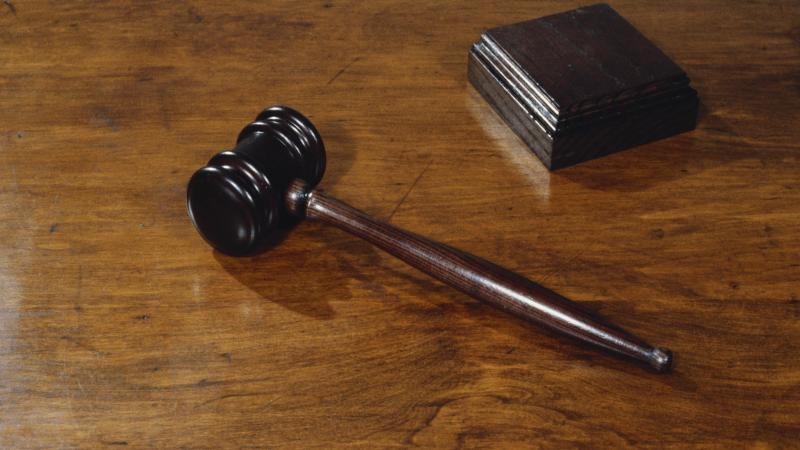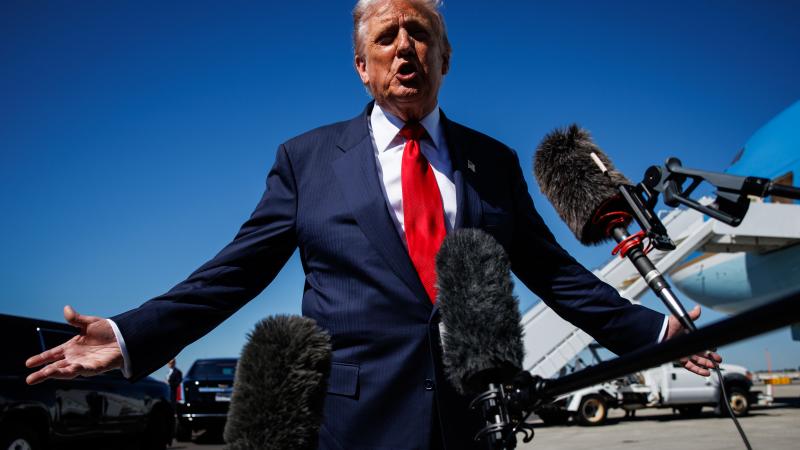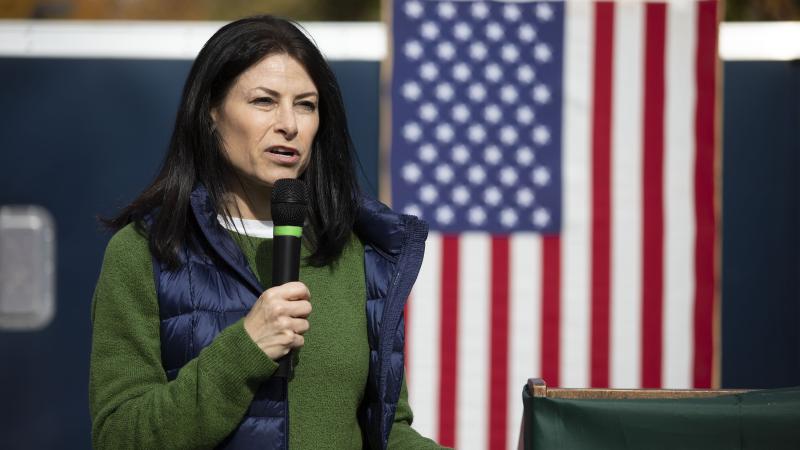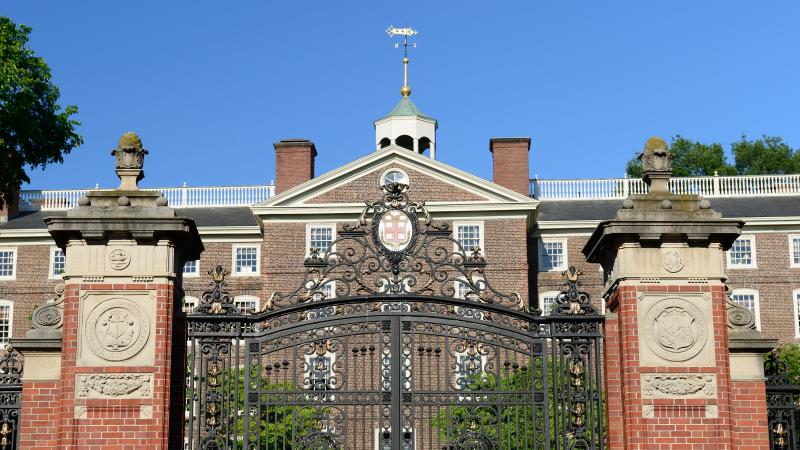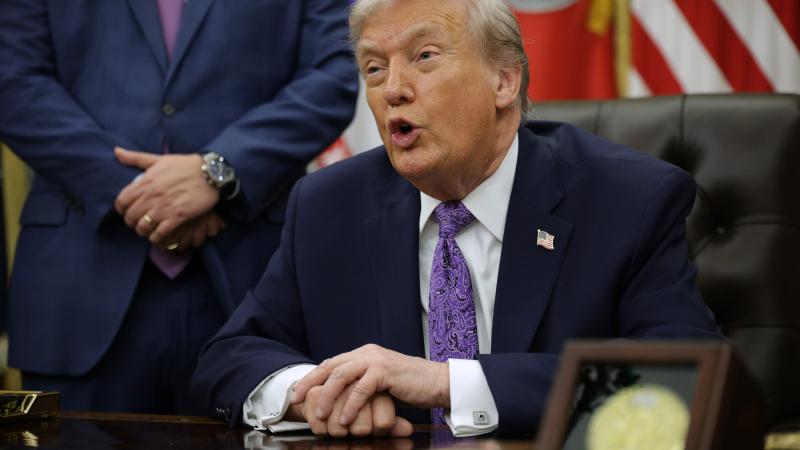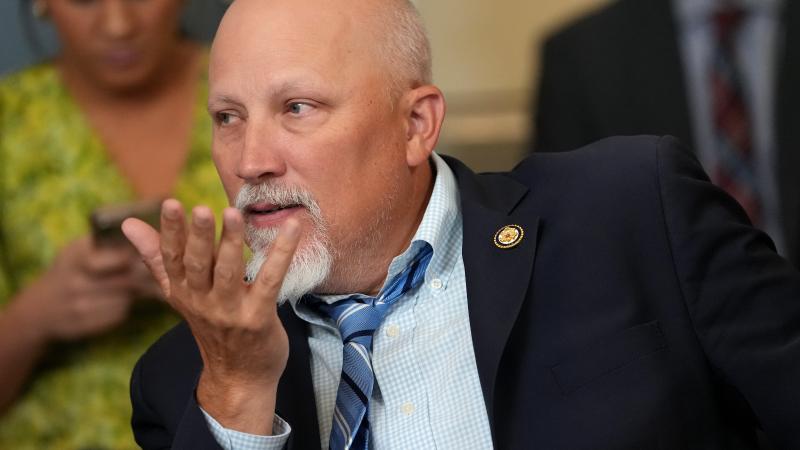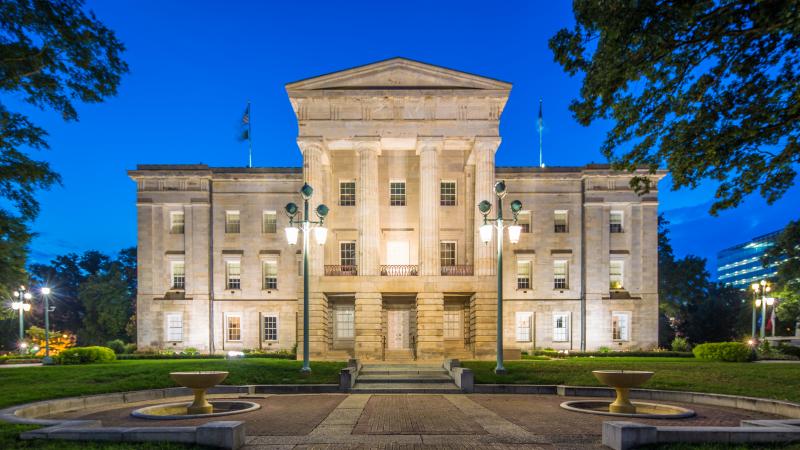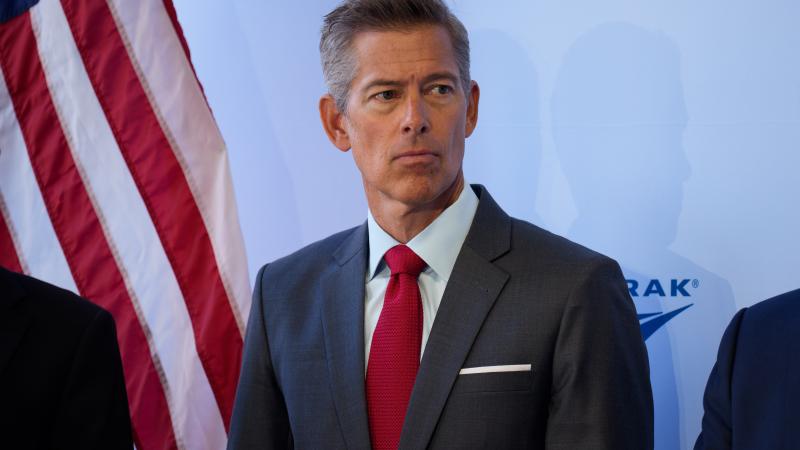DOJ obstruction charge on Comey relates to denying knowing about Clinton Plan on Trump and Russia
Comey's allegedly false denial that he did not remember being briefed about the Clinton Plan intelligence will still be central to the DOJ's prosecution.
The Justice Department failed to secure an indictment against ex-FBI Director James Comey charging him with lying when he claimed that he did not recall a CIA referral memo on Hillary Clinton’s 2016 campaign plan to tie Donald Trump to Russia. But the DOJ is now revealing the false-statements allegation will still be used to support its successful indictment charging Comey with obstructing Congress.
The DOJ’s two-count indictment, approved by a federal grand jury in September, stemmed from allegations that Comey misled the Senate during his testimony in late September 2020, when he reiterated his May 2017 denial that he had never authorized a leak of information to the media about the Trump-Russia investigation or Clinton-related investigations, when the DOJ says he in fact authorized his friend, confidante, and Special Government employee Dan Richman to leak to the media about the FBI’s Hillary Clinton investigation. The indictment also alleged that Comey had obstructed Congress by lying to the Senate.
The foreperson for the grand jury told the judge in September that, in addition to approving the two charges, “grand jurors did not concur in finding an indictment in this case” related to the DOJ’s allegation that Comey had also lied when he claimed before the Senate in September 2020 that he did not remember the CIA referral about the Clinton Plan intelligence.
But the Justice Department revealed in court filings late last week that the approved congressional obstruction count against Comey not only focuses on the ex-bureau chief allegedly misleading about authorizing media leaks but “also rests on the defendant’s statements to Senators [Lindsey] Graham and [Josh] Hawley regarding his alleged lack of memory on the so-called Clinton plan to ‘tie Trump’ to Russia.”
Special Counsel John Durham’s 2023 public report revealed that “the Intelligence Community received the Clinton Plan intelligence in late July 2016.”
The intelligence related to an alleged plan by the Clinton campaign to attempt to link Trump to Russia and Vladimir Putin in an effort to distract from her private email server scandal. The Durham report showed that Comey was briefed on the Clinton Plan intelligence by then-CIA Director John Brennan in early August 2016 and was also sent a CIA referral memo about the Clinton Plan intelligence in early September 2016.
Nevertheless, Comey repeatedly told the Senate Judiciary Committee in late September 2020 that he did not recall the referral memo from the CIA. The Trump DOJ’s efforts to indict Comey over that piece of his testimony as a third count failed, but it appears the DOJ is incorporating that bit of Comey’s alleged wrongdoing into its grand jury-approved congressional obstruction indictment.
Comey, fired as FBI director in 2017 by President Trump, oversaw the politicized investigation into Clinton's use of a private email server to send classified information and the baseless Trump-Russia collusion inquiry.
The indictments were brought by interim U.S. Attorney for the Eastern District of Virginia Lindsey Halligan. The former personal Donald Trump lawyer and White House aide was sworn in in September, shortly before obtaining the indictments against Comey.
The former bureau chief did not immediately respond to a request for comment sent to him through his lawyer, former DOJ veteran Patrick Fitzgerald.
Grand jury approves two counts — but rejects third
The successful indictment specified two counts: False statements within the jurisdiction of the legislative branch of the United States Government (18 U.S.C. § 1001(a)(2)) and Obstruction of a Congressional proceeding (18 U.S.C. § 1505).
The indictment alleges that Comey "did willfully and knowingly make a materially false, fictitious, and fraudulent statement in a matter within the jurisdiction of the legislative branch of the Government of the United States, by falsely stating to a U.S. Senator during a Senate Judiciary Committee hearing that he, [Comey] had not 'authorized someone else at the FBI to be an anonymous source in news reports' regarding an FBI investigation concerning PERSON 1."
The identity of "Person 1" has been revealed to be Hillary Clinton.
The second count of the indictment charges that Comey engaged in "obstruction of a Congressional proceeding" because he "did corruptly endeavor to influence, obstruct, and impede the due and proper exercise of the power of inquiry under which an investigation was being had before the Senate Judiciary Committee by making false and misleading statements before that committee."
A court filing in September also included a “Report of a Grand Jury’s Failure to Concur in an Indictment.” The foreperson of the grand jury, in Alexandria, Virginia, had told the court that “12 or more grand jurors did not concur in finding an indictment in this case.” A handwritten note specified that the rejection of an indictment was only for the count related to Comey’s denial about remembering the Clinton Plan intelligence referral.
DOJ uses allegations from failed third count to buttress obstruction count
The count rejected by the grand jury alleged violation of the same law upon which the grand jury also approved another count, namely, “false statements within the jurisdiction of the legislative branch of the United States Government.”
That rejected charge read: “On or about September 30, 2020, in the Eastern District of Virginia, the defendant, [Comey], did willfully and knowingly make a materially false, fictitious, and fraudulent statement in a matter within the jurisdiction of the legislative branch of the Government of the United States, by falsely stating to a U.S. Senator during a Senate Judiciary Committee hearing that he, [Comey] did not remember ‘being taught’ of PERSON 1’s [Clinton’s] ‘approval of a plan concerning’ PERSON 2 and the 2016 U.S. Presidential election,” the count put forward by the DOJ and rejected by the grand jury stated.
From context, it is clear that "Person 2" is Donald Trump.
Halligan and the Trump DOJ told the court late last week that, despite Comey’s denials in September 2020, “the government has nevertheless determined that the defendant’s handwritten notes appear to show that he was informed in September 2016 regarding an ‘HRC plan to tie Trump’.”
The Trump DOJ said last week that it planned to bring up Comey’s September 2020 denials about knowledge of the Clinton Plan intelligence when seeking to convict him over allegedly obstructing Congress, arguing that they would use “the defendant’s statements to Senators [Chuck] Grassley and [Ted] Cruz regarding his use of Richman as an anonymous source concerning the Clinton email investigation and his statements to Senators Graham and Hawley regarding his alleged lack of memory concerning the so-called Clinton plan to ‘tie Trump’ to Russia” and that that information and other evidence provided was “more than sufficient for defendant’s pretrial preparation as to Count Two.”
Earlier this month, the DOJ also showed that despite Comey telling Congress he didn’t recall this he had taken handwritten notes in September 2016 indicating he had indeed been briefed on the Clinton Plan intelligence.
“An additional record discovered as part of this management review process was an original referral by the Central Intelligence Agency to former FBI Director James Comey,” a document recently penned by the FBI said.
The counterintelligence operational lead was dated Sept. 7, 2016, and was “believed to have been missing for years,” the FBI said, with agents writing that it was found “in a storage closet adjacent to the Director’s office.”
The DOJ wrote that “inside a locked safe within Room 9582, investigators located copies of handwritten notes of the defendant when he was the Director of the FBI.”
The prosecutors added that Comey’s handwritten notes “were not known to any prior investigative teams.”
Russiagate-related subpoenas are also being sent out as new revelations indicate that Comey expected Clinton to emerge victorious in 2016, that key information on Crossfire Hurricane and other FBI investigations was hidden in burn bags at FBI headquarters, and that Richman allegedly leaked to the media despite FBI guidelines warning him not to.
Comey claims not to remember bombshell CIA referral
Then-Senate Judiciary Committee Chairman Lindsey Graham, R-S.C., pressed Comey on his handling of the Clinton Plan intelligence on September 30, 2020 – with Comey contending he did not remember receiving a CIA referral about it in September 2016.
“Do you recall getting an inquiry from […] the intelligence community in September 2016 about a concern that the Clinton campaign was going to create a scandal regarding Trump and Russia?” Graham asked in 2020.
Comey testified: “I do not.”
“You don’t remember getting an investigatory lead from the intelligence community? […] September the 7th, 2016, U.S. intelligence officials forwarded an investigative referral to FBI Director James Comey and Assistant Director of Counterintelligence Peter Strzok regarding U.S. presidential candidate Hillary Clinton's approval of a plan concerning U.S. presidential candidate Donald Trump and Russian hackers hampering U.S. elections as a means of distracting the public from her use of a private email server,” Graham posited. “You don't remember getting that or being taught, that doesn't ring a bell?”
Comey testified: “That doesn't ring any bells with me.”
Graham replied, “OK, well, that's a pretty stunning thing. It didn't ring a bell, but it did come to you. Let's just end with this, you get this inquiry from the intelligence committee to look at the Clinton campaign basically trying to create a distraction, accusing Trump of being a Russian agent or a Russian stooge or whatever to distract from her email server problems."
Pressing the question, Graham continued: "And how far-fetched is that, Mr. Comey, when we now know that the Democratic Party through Fusion GPS hired Christopher Steele, a foreign agent who had a very strong bias against Trump who hired a Russian sub-source who the FBI believed to be a Russian spy to compile a dossier that was a bunch of crap to be used against an American citizen working for the Trump campaign?” Graham said. “You already knew that. Seems to me, you'd want to investigate other allegations, but you're telling me that you don't recall this.”
Comey interjected: “I'm sorry, senator, is there a question?”
Graham replied: “Yes. You don't recall this inquiry I just read about September 2016?”
Comey again denied remembering this, saying: “No, as I said, it doesn't [...] It doesn't sound familiar.”
Hawley, a Missouri Republican, also pressed Comey on Brennan’s September 2016 investigative referral sent to the FBI, which had been revealed in 2020 by then-Director of National Intelligence and current CIA Director John Ratcliffe.
“The letter to Chairman Graham from John Ratcliffe, which I know you've seen Mr. Comey, as you mentioned it earlier, Mr. Ratcliffe says on 7 September 2016, U.S. intelligence officials forwarded an investigative referral to FBI director James Comey regarding U.S. presidential candidate Hillary Clinton's approval of a plan concerning Donald Trump and Russian hackers as a means of distracting the public from her use of a private mail server. Did you open an investigation?” Hawley asked.
Comey testified: “I don't know what that refers to. As I said earlier, that does not ring any bells with me when I read that.”
“You did not receive any investigative referral of this nature?” Hawley asked again.
Comey replied: “I don't remember it. I don't remember receiving anything that's described in that letter.”
“I find it extraordinary that a referral from the IC to the FBI regarding Hillary Clinton's campaign and potential illicit activity received no — no — attention from the FBI,” Hawley said. “So little attention the director doesn't even recall it. And yet the director and others had plenty of time to go and seek surveillance warrants during an ongoing presidential campaign — warrants so flawed that the FISA court has now said it can't trust what the FBI says in future cases. This is an extraordinary abuse of power and it's time we held people responsible for it.”
Comey was briefed by Brennan and sent a referral by the CIA
Durham said Brennan's handwritten notes reflect that Brennan briefed Comey, then-President Barack Obama, then-Vice President Joe Biden and others by early August 2016 regarding the "alleged approval by Hillary Clinton on 26 July [2016] of a proposal from one of her [campaign] advisors to vilify Donald Trump by stirring up a scandal claiming interference by the Russian security services."
The Durham report also said that the Clinton Plan intelligence “was also of enough importance for the CIA to send a formal written referral memorandum” to Comey and since-fired Deputy Assistant Director of the FBI's Counterintelligence Division, Peter Strzok, “for their consideration and action.”
Nevertheless, Comey repeatedly told the Senate in September 2020 that “I do not” recall the CIA referral, and that it “doesn’t ring any bells with me” and “doesn’t sound familiar.”
The Durham report said that the CIA’s referral memo stated that the FBI had “made a verbal request for examples of relevant information the fusion cell had obtained.”
FBI Supervisory Analyst Brian Auten told Durham’s investigators that on the Friday before Labor Day – Sept. 2, 2016 – CIA personnel had briefed Auten, FBI intelligence section chief Jonathan Moffa and possibly “FBI OGC [Office of General Counsel] Unit Chief-1” at FBI Headquarters “on the Clinton intelligence plan” and that “Auten advised that at the time he wanted to see an actual investigative referral memo on the information.” The CIA soon sent that info to Comey and Strzok.
The CIA referral memo to Comey and Strzok – completed on Sept. 7, 2016 – said that the “CIA provides the below examples of information the CROSSFIRE HURRICANE fusion cell has gleaned to date” and showed that the CIA believed Clinton's false narrative would suggest Trump and Russian hackers were hampering U.S. elections, and that Clinton's end goal was "distracting the public from her use of a private email server."
Durham found that, rather than seriously investigating this alleged Clinton scheme, the Obama administration's intelligence and law enforcement apparatus – led by Comey’s FBI – nonetheless pushed forward on the baseless Trump-Russia collusion saga.
Declassified records show that intercepts of purported Russian intelligence may have also swayed Comey’s handling of the FBI’s investigation into Clinton using her illicit private email server to send classified information.
Clinton Plan intelligence hidden from key FBI officials
Key FBI officials from whom the Clinton Plan intelligence was hidden later told Durham that they were upset by this concealment and that they should have seen it in 2016. Many FBI personnel involved with Crossfire Hurricane had never seen the Clinton Plan intelligence until Durham’s team showed it to them, and “some expressed surprise and dismay upon learning of it,” the report found.
Durham’s report said that “Supervisory Special Agent-1” – purportedly former FBI agent Joe Pientka – “became visibly upset and emotional” when Durham’s team showed him the Clinton Plan intelligence in 2020, with the report saying that the agent “left the interview room with his counsel, and subsequently returned to state emphatically that he had never been apprised of the Clinton Plan intelligence and had never seen the aforementioned Referral Memo.”
“Supervisory Special Agent-1 expressed a sense of betrayal that no one had informed him of the intelligence,” the Durham report said. “When the Office cautioned Supervisory Special Agent-1 that we had not verified or corroborated the accuracy of the intelligence and its assertions regarding the Clinton campaign, Supervisory Special Agent-1 responded firmly that regardless of whether its contents were true, he should have been informed of it.”
Then-FBI General Counsel James Baker also later told Durham “that he had neither seen nor heard of the Clinton Plan intelligence or the resulting Referral Memo prior to his interview,” according to Durham's report.
Baker said that “had he known of it during the Crossfire Hurricane investigation, he would have viewed in a different and much more skeptical light” the anti-Trump Steele Dossier and the Alfa Bank claims.
Clinton Plan intel circulated within Obama IC
According to Durham’s 2023 report, the purported scheme by Clinton was allegedly approved on July 26, 2016 – in the middle of the 2016 Democratic National Convention nominating Clinton for president.
The report also noted that the approval of the Clinton Plan occurred the exact same day that Australian diplomat Alexander Downer – a Clinton supporter – provided the U.S. government a months-old tip about Trump campaign associate George Papadopoulos – with Downer’s tip cited as the predicate to launch Crossfire Hurricane at the end of July 2016.
The Durham declassified annex said that the “FBI was fully alerted to the possibility that at least some of the information it was receiving about the Trump campaign might have its origin either with the Clinton campaign or its supporters, or alternatively, was the product of Russian disinformation.”
But the annex stated that “despite this awareness” – that it might be dealing with a Russian falsehood or alternatively with a genuine Clinton campaign dirty trick – “the FBI appears to have dismissed the [intelligence information] as not credible without any investigative steps actually having been taken to either corroborate or disprove the allegations.”
The declassified appendix added that, after Trump’s win in November 2016, it was only in 2017 that the “CIA prepared a written assessment of the authenticity and veracity of the above-referenced intelligence. The CIA stated that it did not assess that the above [REDACTED] memoranda, or [REDACTED] hacked U.S. communications, to be the product of Russian fabrications.”
The annex also revealed that besides the July 2016 Clinton Plan intelligence the Obama administration received information from a source which was contained in two memoranda.
The January 2016 memo detailed the alleged intention by then-President Obama to scuttle the FBI’s investigation into Clinton’s illicit private email server.
The March 2016 memo alleged that “[the Democratic Party’s] opposition is focused on discrediting Trump. [...] [a]mong other things, the Clinton staff, with support from special services, is preparing scandalous revelations of business relations between Trump and the ‘Russian Mafia’.”
Durham said that FBI analysts believed that, at the time, the “special services” in the March 2016 memo could refer “to the FBI and the CIA or more broadly to the intelligence and law enforcement communities” inside the United States. But other analysts speculated that it could refer to “Trump dossier author Christopher Steele.”
Clinton campaign hinged on efforts to link Trump to Putin
Public records show Clinton, in coordination with her campaign general counsel Marc Elias, campaign manager Robby Mook, campaign chairman John Podesta, campaign communications director Jennifer Palmieri, campaign policy adviser Jake Sullivan, and others launched an effort to link Trump to Putin as the 2016 battle for the White House raged. That effort was largely successful, injecting the Trump/Putin narrative into legacy media and DNC talking points.
The Clinton campaign and its paid operatives engaged in a lengthy and coordinated effort to tie Trump to Russia during the 2016 election, including: TV appearances, speeches and public pronouncements; an aggressive news and social media strategy; British ex-spy Christopher Steele’s decision to bring his now-discredited dossier to the FBI; and the spreading of debunked claims to the FBI and the public related to the Trump Organization and Russia’s Alfa Bank.
Then-Vice President Biden sought to publicly link Trump to Putin after U.S. intelligence intercepted a purported plan by Clinton's campaign to vilify Trump by falsely linking him to a Russian plot.
The former spy chief who organized and co-authored the infamous Hunter Biden laptop letter ahead of the 2020 election is the same person who also played a key role in helping Clinton in 2016 appear to try to smear Trump by tying him to Putin. Mike Morell, the former acting CIA director, inserted into the American political consciousness the idea that Trump was an “agent” of Putin and Russia, a refrain that would be repeated over and over again by the Clinton campaign and a cooperative media in the summer and fall of 2016.
Comey said on Instagram in September of this year after the Trump DOJ indictment was announced: "My heart is broken for the Department of Justice, but I have great confidence in the federal judicial system.” The fired FBI chief added: “And I’m innocent. So let’s have a trial. And keep the faith.”
He pleaded not guilty in October, and he has sought to disqualify Halligan and get the indictment dismissed. Comey’s trial is slated to begin in January.
The Facts Inside Our Reporter's Notebook
Links
- indictment
- Dan Richman
- told the judge
- claimed before the Senate
- revealed in court filings
- revealed
- 18 U.S.C. § 1001(a)(2)
- 18 U.S.C. § 1505
- second count
- court filing
- alleged
- stated
- told the court
- said
- showed
- Clinton Plan intelligence
- wrote
- added
- being sent out
- expected
- burn bags
- leaked
- warning
- contending
- also pressed
- reflect
- repeatedly told
- said
- showed
- intercepts
- told
- said
- said
- told
- noted
- declassified annex
- added
- alleged intention
- alleged
- launched an effort
- publicly link
- organized and co-authored
- agent of Putin and Russia
- said
- pleaded not guilty
